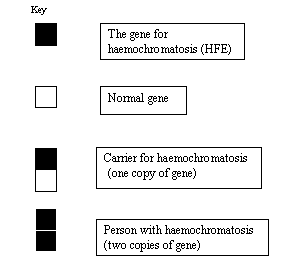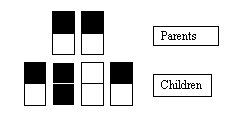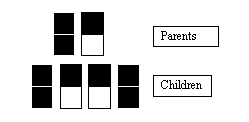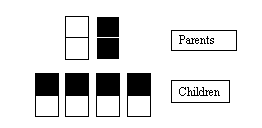Haemochromatosis
Haemochromatosis
Haemochromatosis is a chronic (long-term) disorder involving the excessive absorption and inappropriate storage of iron. Symptoms may become evident as a person ages, ranging from lethargy to more serious health problems. Treatment includes regular removal of blood because much of the body's iron is contained in red blood cells.
Haemochromatosis has a genetic cause and is considered to be the most common genetic disease in the world.
Haemochromatosis occurs in men 2 to 3 times more often than in women. It usually becomes apparent after the age of 40 in men and age 50 in women. The appearance of haemochromatosis occurs later in women because menstruation causes blood loss, which increases iron removal.
General information
Iron is a mineral essential for life. It binds with haemoglobin, a molecule in the blood, to transport oxygen from the lungs to all the tissues of the body. During the digestion of food the body absorbs iron through the intestines. In people without haemochromatosis the body only absorbs as much iron as it needs, with the rest being excreted by the body. However, in people with haemochromatosis, absorption is uncontrolled and the body absorbs excessive amounts of iron. The excess iron is unable to be utilised by the body and is deposited in body organs such as the liver, heart, pancreas and kidneys. This excess iron is toxic to the organs and over time can lead to damage and loss of function.
The condition may also be known as iron overload syndrome, inherited iron overload disease and bronze diabetes. Other causes of iron overload include multiple blood transfusions, chronic hepatitis C infection, alcoholic liver disease and various haematological (blood) disorders.
Signs and symptoms
Haemochromatosis often displays no symptoms. But, as a person ages, and iron accumulates, some signs and symptoms may become evident. These may include:
- Tiredness/fatigue/lethargy
- Abdominal discomfort
- Joint pain
- Low libido
- A feeling of being generally unwell.
These symptoms may not be present at all, or may be attributed to other health problems, which means the condition can go unrecognised for some time. As the condition progresses, more serious problems may occur including:
- Enlarged liver in more than 95% of patients, often accompanied by chronic liver disease (cirrhosis) and liver failure
- Diabetes mellitus, often requiring insulin therapy
- Cardiomyopathy (disease of the heart muscle)
- Reproductive problems due to erectile dysfunction (impotence) and loss of sex drive
- Skin pigmentation - many with the condition develop a "bronzed" or grey complexion.
People with haemochromatosis may develop one or more of the above symptoms over a period of time as iron slowly accumulates and deposits in the body's organs. Often the disease is not diagnosed until routine blood tests show elevated blood iron levels.
Causes
Haemochromatosis is caused by a mutation in a gene that controls the amount of iron that the body absorbs from food. Discovered in 1996, the gene is known as the HFE gene. It is a recessive gene, which means that a person with haemochromatosis must have received it from both parents and will have two copies of the gene. A carrier will have one copy of the gene but not have the disease. For example:

If both parents have haemochromatosis then they both have two copies of the gene. All their children will have haemochromatosis.

If both parents are carriers then they both have one copy of the gene. There is a one in four chance of a child having haemochromatosis, two chances in four that they will be carriers and one chance in four that they will neither have haemochromatosis nor be a carrier.

If one parent has haemochromatosis (ie: has two copies of the gene) and the other parent is a carrier (ie, has one copy of the gene), the children will have haemochromatosis or be carriers for the condition.

If one parent has haemochromatosis (ie, has two copies of the gene) and the other parent does not have a copy of the gene, then all the children will be carriers, but will not have the condition.

Diagnosis
Early diagnosis is vital to prevent organ damage. However, as the condition can take years to become apparent, and symptoms mimic other conditions, diagnosis can be difficult.
If haemochromatosis is suspected, the diagnosis can usually be confirmed by blood tests. The blood tests will check transferrin saturation (how much iron is in the blood) and serum ferritin levels (how much iron is stored).
The normal iron saturation level is between 20 and 40%. The normal serum ferritin levels are 20–250µg/L (micrograms per litre) for an adult male and 20–160µg/L for an adult female. Haemochromatosis will be suspected if the transferrin saturation is above 55% and the serum ferritin is above 400µg/L.
The doctor will also take a full medical history, including any family history of haemochromatosis and will discuss current symptoms. This, combined with the characteristic blood test results, will assist with the accurate diagnosis of the condition.
Blood tests to assess liver function will be performed. If they are abnormal, a liver biopsy may be recommended to check for liver damage. Additionally, x-rays and specialised scans may be necessary to assess whether damage has occurred in other organs.
Once a diagnosis of haemochromatosis has been made, it is usually recommended that close blood relatives (siblings, children, parents) are screened for the condition. Whilst haemochromatosis cannot be prevented, early diagnosis and treatment can prevent the development of symptoms and long-term consequences of the condition.
Treatment
Once diagnosed, treatment for haemochromatosis is lifelong and involves the removal of excess iron. This is done by removing blood in a process similar to blood donation called venesection or phlebotomy. Blood is removed at weekly sessions until the ferritin level is below approximately 50µg/L and transferrin saturation is less than 50%. After this is achieved, blood is taken as often as necessary to keep ferritin at this level.
Regular venesection may not be possible in some people, eg: those with anaemia (low levels of red blood cells) or heart disease. In these cases chelation therapy might be recommended, which involves taking a medication to remove excess iron. The medication, or chelating agent, binds excess iron which is then expelled via the urine or stools.
If organ damage occurred prior to the diagnosis of haemochromatosis, treatments aimed at repairing the damaged organ will be necessary. If permanent and severe damage has occurred, an organ transplant may be required.
General lifestyle guidelines for people with haemochromatosis include:
- Avoiding excessive red meat and liver in the diet
- Avoiding alcohol
- Avoiding vitamin supplements containing vitamin C and iron
- Not consuming raw shellfish
- Eating a balanced diet
- Drinking team or coffee with iron-rich meals as this may reduce iron absorption.
- eHealth,Health,HealthCare, Health Care
